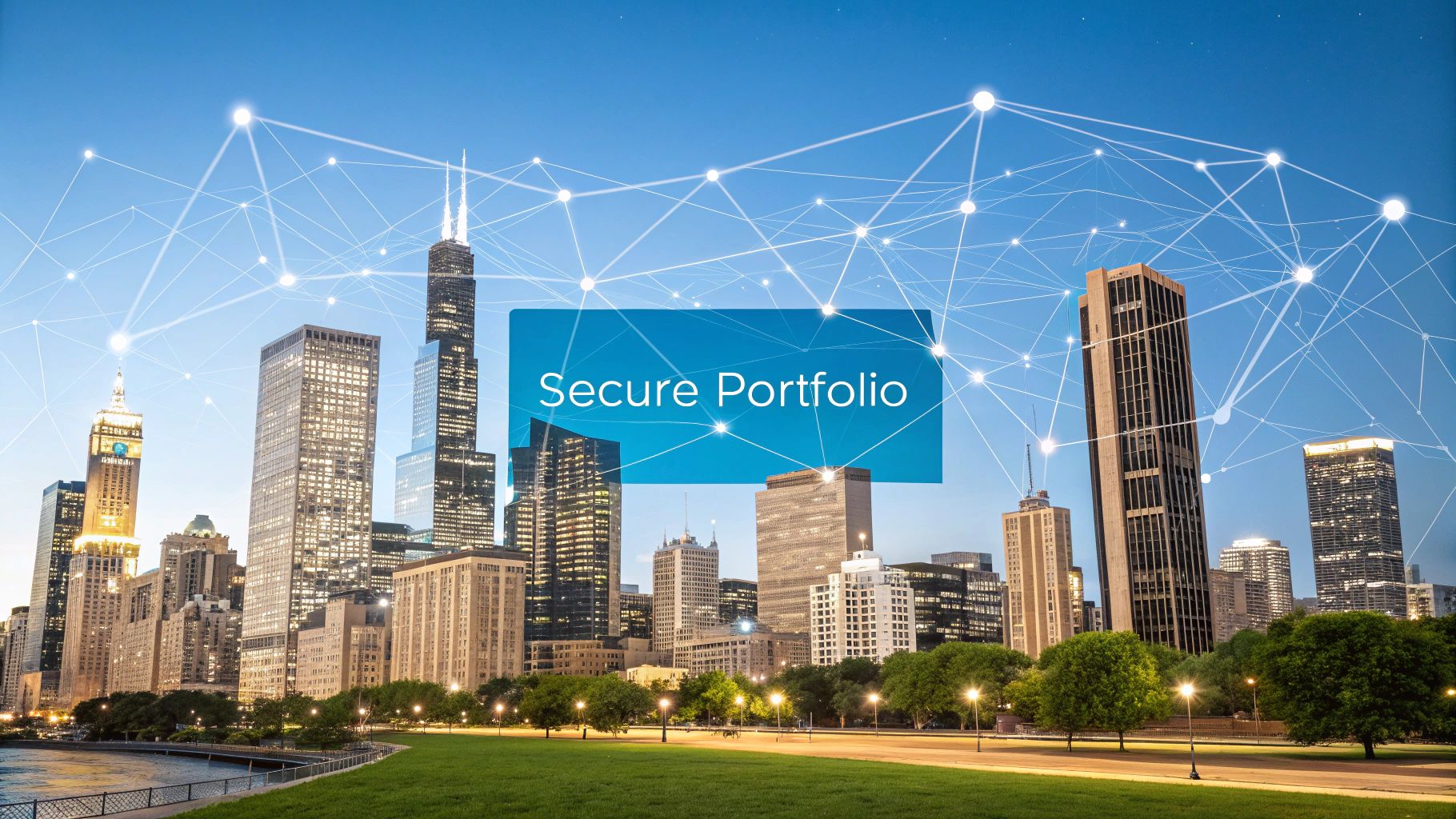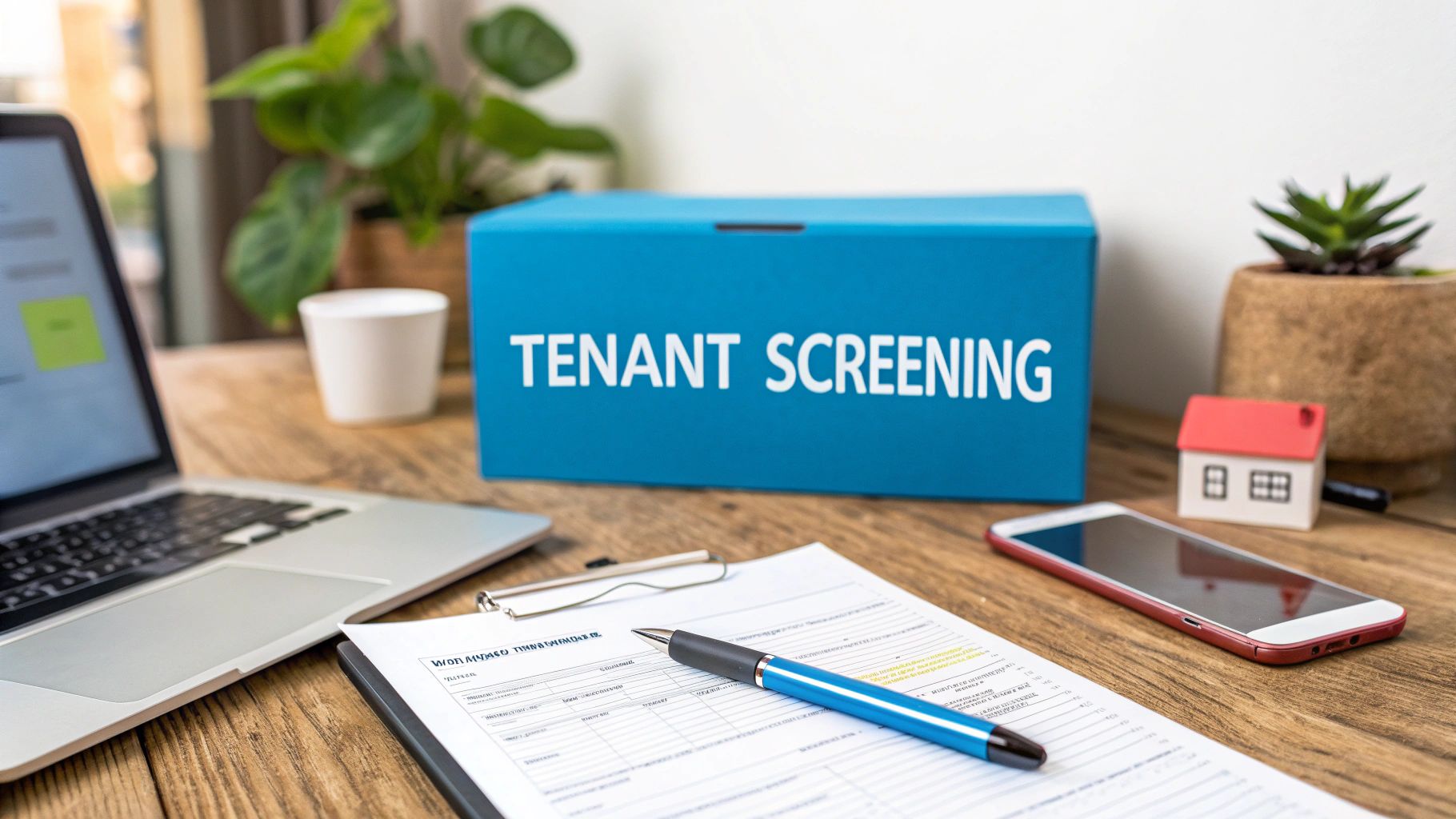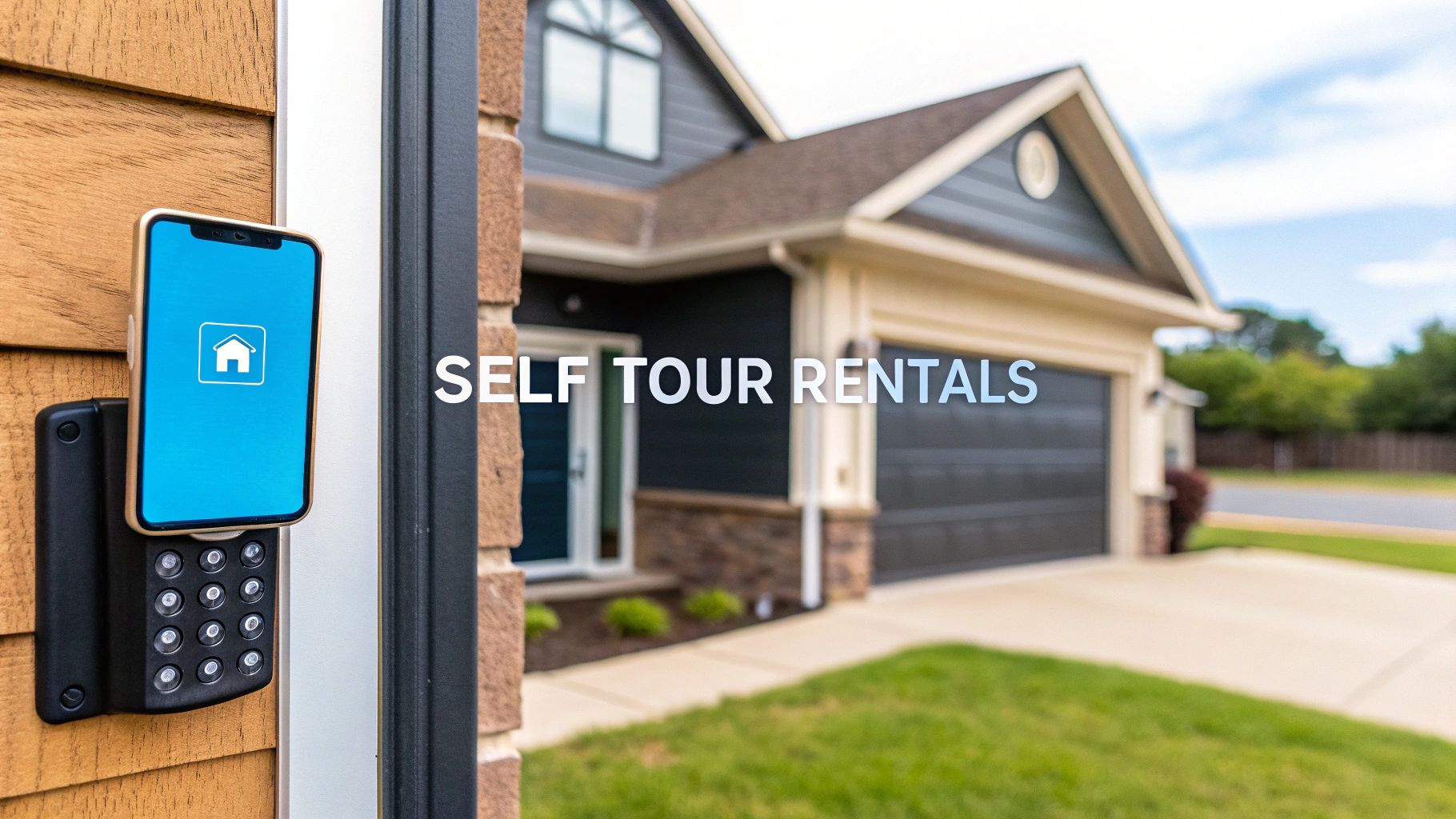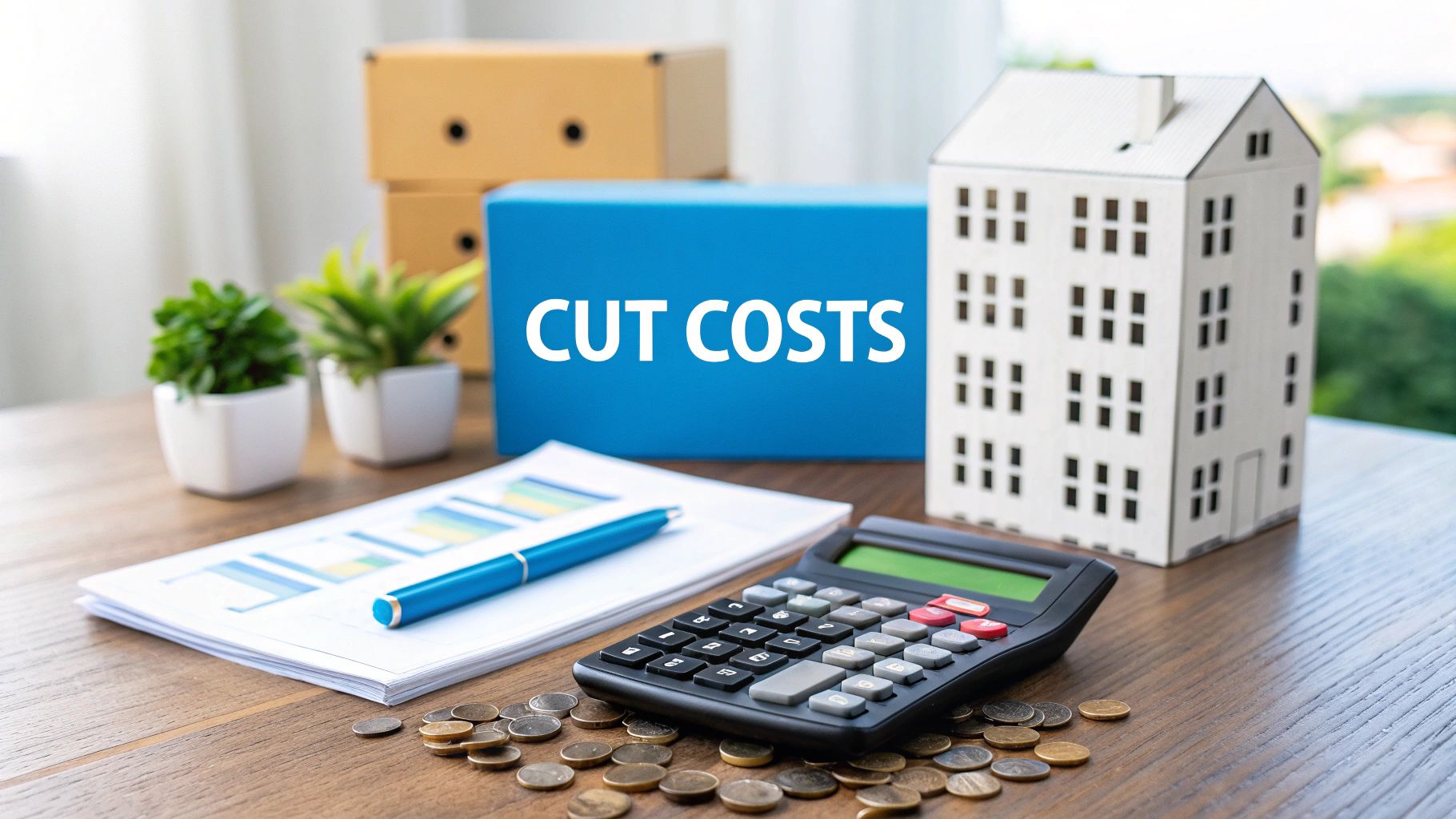When you hear "property management security," you might think of locks and alarm systems. That's fine for a handful of properties. But when you're managing hundreds—or thousands—of rental units spread across different markets, security takes on a new, critical meaning for your operational efficiency and bottom line.
It’s no longer just about protecting a single asset. For large-scale operators, security is the operational backbone that enables remote management of a distributed portfolio, minimizes risk across thousands of doors, and drives the revenue performance that fuels growth. A robust secured property management strategy isn't a feature; it's the foundation of a scalable, profitable business.
Redefining Security for Enterprise-Scale Portfolios
For property management companies managing 1,000+ units, the old playbook is obsolete. Traditional security methods crumble under the weight of multi-market complexity and the relentless pressure to reduce Days on Market (DOM). You can't be everywhere at once. That's why a modern, integrated approach is critical—it protects your physical assets, your data, and most importantly, your revenue.
This shift isn't just a trend; it's a necessity driven by market growth and technology. The global property management market is projected to grow from USD 24.01 billion in 2025 to USD 52.99 billion by 2033. This expansion is powered by technology and digitization, which means more data, more complexity, and a greater need for security systems built for enterprise scale. As you plan your growth, it’s worth exploring the future of single-family property management to see how these trends are shaping high-performing operations.
The Three Pillars of Modern Security at Scale
What does a modern security strategy look like for a large, distributed portfolio? It comes down to three core pillars. Each one addresses a different vulnerability that arises when managing properties remotely and at scale. If any one of these pillars weakens, you're opening the door to significant operational and financial risks.
This visual breakdown shows how these pieces fit together to create a secure, scalable framework.
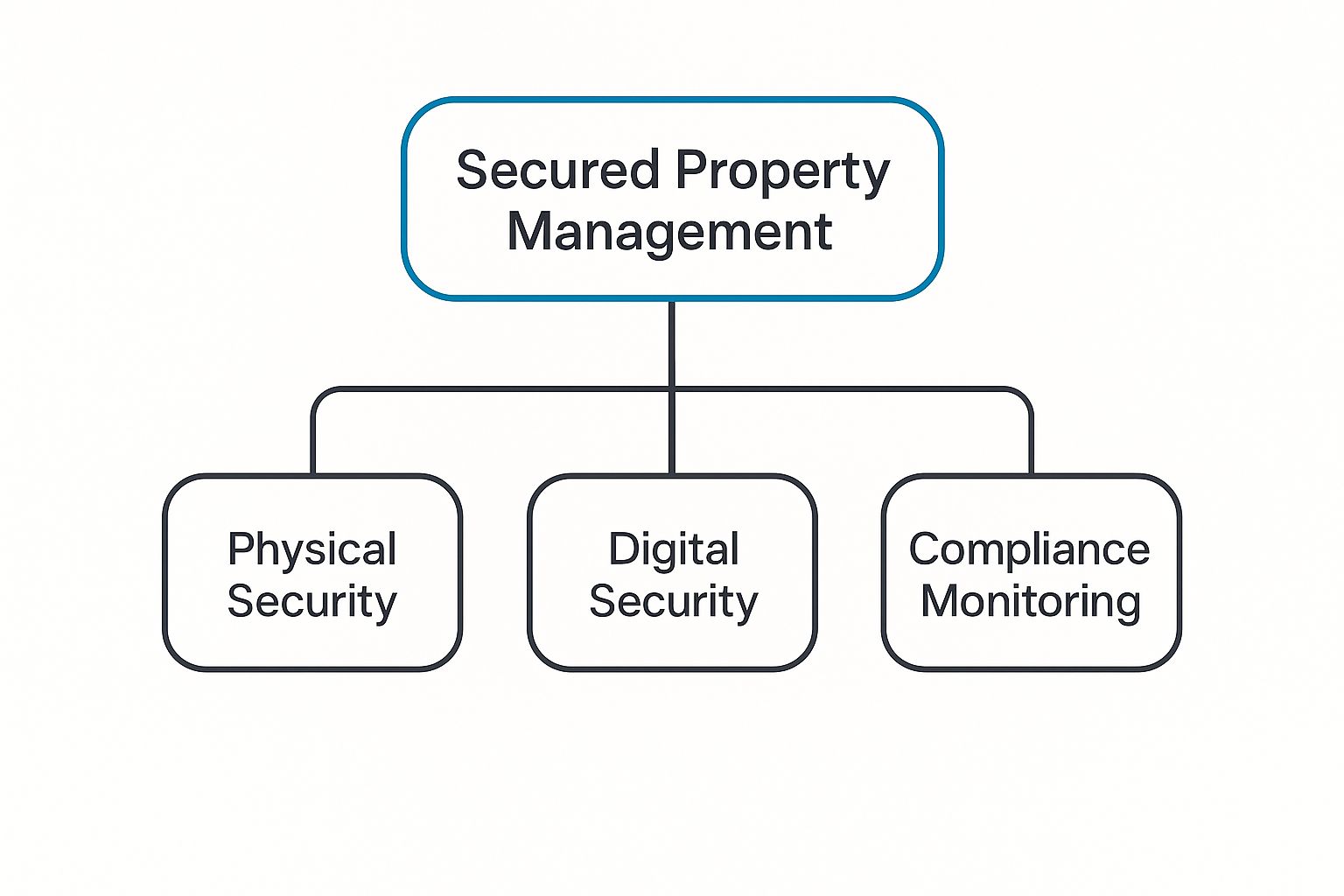
A truly secure operation is a balancing act between physical control, digital defense, and process compliance.
To build a truly scalable operation, you have to master all three. This approach shifts security from a reactive cost center to a proactive strategy that drives revenue. When you fortify these three areas, you're not just protecting properties—you're building trust with owners, attracting better tenants, and enabling confident expansion.
| The Three Pillars of Enterprise Security |
| :--- | :--- | :--- | :--- |
| Pillar | Primary Focus | Key Challenge at Scale | Impact on Revenue |
| Physical Security | Protecting the tangible asset—the property itself—from unauthorized access, vandalism, and squatters. | Maintaining consistent control and monitoring across a geographically dispersed portfolio without being on-site. | Prevents costly repairs, lost rent from squatters, and liability claims, preserving asset value and minimizing vacancy. |
| Digital Security | Safeguarding sensitive data, including tenant information, owner financials, and internal communications. | Defending against sophisticated phishing scams, data breaches, and ransomware attacks across multiple systems. | Protects against massive financial losses, reputational damage, and regulatory fines that can cripple a growing business. |
| Financial & Compliance Security | Ensuring all financial transactions are legitimate and all operations adhere to local, state, and federal regulations. | Managing complex payment systems, preventing fraud, and staying updated on evolving fair housing and trust accounting laws. | Avoids crippling lawsuits, hefty fines, and the loss of your real estate license, ensuring long-term portfolio viability. |
Mastering these pillars is what separates regional players from enterprise-level operators. It's about creating a comprehensive defense system that protects your business from every angle.
Key Takeaway: For enterprise property management, security is not just a feature—it's the operational system that enables remote management, protects revenue, and facilitates scalable growth. It's about building a fortress of trust around your assets, data, and financial operations.
Securing Physical Assets Across Distributed Portfolios
When you're managing hundreds or even thousands of properties scattered across different markets, physical access becomes a massive operational bottleneck. The old-school approach of lockboxes and master keys doesn't work at scale. It’s slow, a major security risk, and a direct drag on your leasing velocity.
Every lost key or un-audited entry isn't just a minor issue—it's a direct hit to your bottom line and a potential liability nightmare. This is where modern secured property management comes in. It’s about more than just preventing break-ins; it’s about building a smart, scalable, and auditable system for property access that directly impacts your speed-to-lease.
Mastering Remote Asset Control with Technology
The game-changer for large-scale property management is centralized access control. Technologies like smart locks and digital key platforms are the new foundation for physical security. They replace cumbersome physical keys with a secure, trackable digital footprint that you control from anywhere.
For multi-market operators, this is a non-negotiable component of a scalable tech stack. Here’s why:
- Centralized Control: Grant or revoke access to any property in your entire portfolio from a single dashboard. No more coordinating key handoffs or driving across town.
- Time-Stamped Audit Trails: Every entry is logged. You get a clear, undeniable history of who was there and when—perfect for managing vendors and ensuring property integrity.
- Temporary Access Codes: Need to let a leasing agent in for a tour or a vendor for a repair? Generate a unique, time-sensitive code that expires automatically. The risk of unaccounted-for keys is eliminated.
A key piece of the puzzle is integrating these smart access solutions with leading home security systems. When your smart locks and security cameras work in concert, you create a powerful, layered defense that ensures every asset is truly monitored and secure. It’s about building a complete physical security strategy that grows with your portfolio.
The Impact on Leasing Velocity and Operational Costs
Here's the critical connection: a streamlined, secure access system does more than just protect your properties. It directly accelerates your leasing cycle and reduces your cost-per-door.
When a qualified lead wants to see a property now, being able to grant immediate, secure access is the difference between a signed lease and a lost opportunity. This is where your lead-to-tour conversion rate is won or lost.
Platforms like Showdigs weave this secure access tech directly into the leasing workflow. By automating tour scheduling and providing secure entry for on-demand agents, you make same-day showings a reality. You convert qualified leads before they have a chance to view a competitor’s listing, dramatically reducing your DOM.
Mini Case Study: Slashing Costs and Securing a Portfolio
A multi-market operator managing 1,500 single-family rentals was struggling with high rekeying costs and frequent unauthorized access from old lockboxes. After implementing a portfolio-wide smart lock system integrated with their showing platform, they cut rekeying expenses by 60% in the first year. More importantly, the auditable access logs and secure codes led to an 80% drop in unauthorized access incidents, boosting operational efficiency and reducing liability.
This example proves that investing in modern access technology isn't a cost—it's a driver of profitability. By standardizing physical security, you eliminate operational friction, slash unnecessary expenses, and build a trusted environment that gets properties leased faster.
Building Your Digital Fortress of Trust
Physical security is only half the battle. In property management, some of your most valuable—and vulnerable—assets are digital. Enterprise-level property management companies are data goldmines, holding everything from tenant Social Security numbers and owner financial statements to sensitive internal communications. This makes them a prime target for cyberattacks.
A single data breach can do more than just cause a financial headache. It can shatter your company's reputation and destroy the trust you've painstakingly built with clients and residents. That’s why building a resilient cybersecurity posture isn't just an IT task—it's a core component of secured property management that protects your brand and ensures long-term viability.
Think of it as building a digital fortress around your operations.
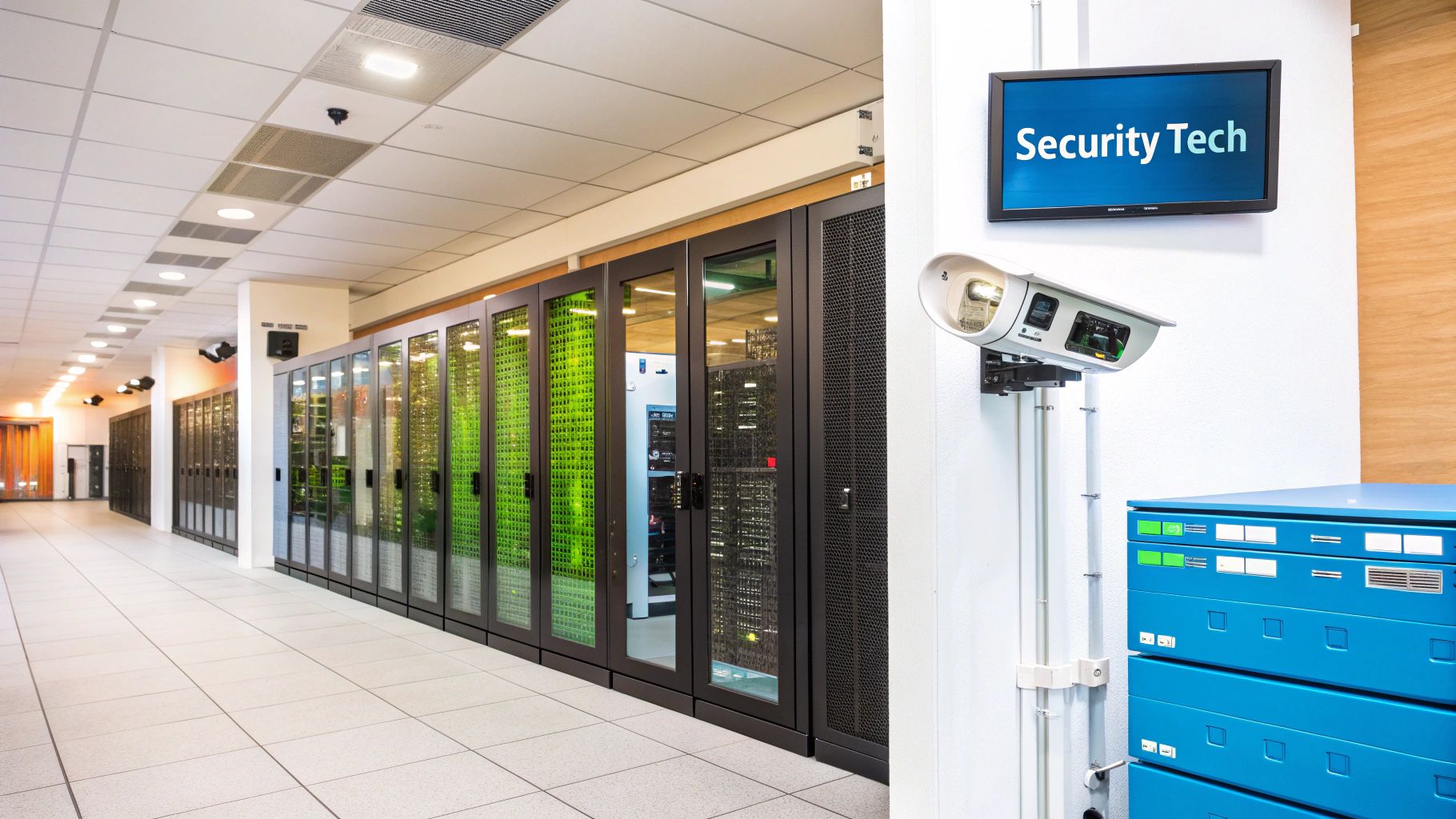
Auditing Your PropTech Stack Security
Your digital fortress is only as strong as its weakest wall. For most large-scale operators, that weakness often lurks within the PropTech stack itself. Every piece of software, every API integration, and every third-party vendor represents a potential entry point for threats. A proactive security audit isn't just a good idea; it's essential.
Start by auditing the foundational security layers of every tool you use.
- End-to-End Encryption: Is all data, whether at rest in a database or in transit between systems, fully encrypted? This is non-negotiable. Encryption makes information unreadable to outsiders even if they manage to intercept it.
- Secure API Integrations: Your systems need to communicate, but those connections must be secure. Vet the API security protocols of all your software partners to prevent data leakage between your PMS, CRM, and showing platforms.
- Robust Payment Processing: Online payment portals are a huge target for cybercriminals. Verify that your payment processor is PCI-compliant and uses advanced fraud detection to protect both owner and tenant financial data.
This process is about creating multiple layers of defense. Just like a real fortress has moats, walls, and guards, your digital security relies on a mix of encryption, secure access controls, and vigilant monitoring to keep threats out.
Safeguarding Data to Maintain Compliance
Protecting data isn't just good practice—it's the law. Regulations like the California Consumer Privacy Act (CCPA) and Europe's General Data Protection Regulation (GDPR) have strict rules about how companies handle personally identifiable information (PII).
For property managers operating in different markets, navigating this complex web of regulations is a major challenge. A data breach that violates these laws can lead to crippling fines and costly lawsuits, hammering home the importance of a tight security framework.
A well-defended digital infrastructure is the bedrock of trust in the modern rental market. It assures owners their financial data is safe and tells prospective tenants that their personal information is respected and protected, directly influencing their decision to lease with you.
The scale of this responsibility is immense. In the United States alone, the property management sector employs nearly 910,000 people, with over 304,000 distinct companies managing vast portfolios. Considering that about 35% of property managers oversee between 101 and 500 units, the sheer volume of sensitive data being handled is staggering. This makes top-tier digital security an absolute must. For a deeper dive into the numbers shaping the industry, you can explore key property management statistics.
Ultimately, your digital fortress does more than protect data—it protects your entire business. By implementing rigorous security protocols across your technology ecosystem, you safeguard your assets, maintain compliance, and build a brand that owners and tenants trust. This is what enables property management companies to scale confidently and securely.
Navigating Financial and Regulatory Compliance
When you're managing an enterprise-level portfolio, a single bad transaction or a compliance slip-up isn't just a small headache. It's a systemic risk—one that can unleash a torrent of financial and legal trouble. Think of financial and regulatory integrity as a foundational pillar of secured property management. It’s all about ensuring every dollar is tracked and every action you take is in line with a complex web of laws.
At scale, this goes way beyond simple bookkeeping. It becomes a sophisticated framework built on automated, auditable, and secure financial operations.
The goal is to design a system where the "right way" is also the easiest way. This means using technology to reduce human error and building transparent workflows that protect both your clients' assets and your company’s reputation. A solid compliance strategy is your best proactive defense against major liability.
Automating Financial Security and Workflows
Manual financial processes are a disaster waiting to happen at scale. An invoice keyed in wrong or a payment misapplied—these tiny mistakes can snowball into massive problems across a large portfolio. Automation is the only viable way to mitigate these risks by creating financial workflows that are consistent, repeatable, and secure.
It all starts with how you handle money coming in. Today’s property management demands a system that's both seamless for tenants and ironclad against fraud.
- Fraud-Resistant Payment Portals: Your online payment system needs serious security capabilities, like tokenization and end-to-end encryption. These technologies act as a digital vault for sensitive financial data, dramatically lowering the risk of a breach.
- Integrated Accounting Systems: Your payment portal must integrate seamlessly with your property management software (PMS). This direct API connection eliminates manual data entry—a major source of human error—and provides a real-time, accurate financial snapshot.
- Automated Reconciliation: The right technology can automatically match payments to the correct tenant and unit, flag anomalies, and make the entire reconciliation process a background task. This saves countless hours and prevents costly mistakes.
By automating these core financial functions, you build an operation that isn't just faster—it's fundamentally more secure.
Standardizing Compliance Across Multiple Markets
Juggling properties across different cities and states is a legal minefield. Landlord-tenant laws, Fair Housing rules, and trust accounting regulations vary significantly. What’s standard practice in one market could be a major violation in another. A standardized compliance framework isn't a nice-to-have; it's essential for multi-market management.
Build your operational playbook around the strictest regulations you have to follow. This "high-water mark" approach creates a baseline of compliance that keeps your entire portfolio safe, with minor adjustments added for local rules.
This forward-thinking stance shifts compliance from a reactive, market-by-market scramble into a well-oiled operational strength. It guarantees that every team member, regardless of location, is working from the same set of secure and compliant procedures.
For a deeper dive into workplace safety and regulatory rules, which are crucial for building a secure environment, you can find valuable information on OSHA Safety Training Requirements. A culture rooted in safety and compliance is the bedrock of any truly secure operation, protecting your team and tenants alike.
Putting a secure financial and regulatory framework in place isn’t just about dodging fines. It’s about building a trustworthy, stable, and scalable operation that gives investors confidence and sets your company up for long-term growth.
Calculating the ROI of Your Security Strategy
For any operations director or portfolio manager, every dollar spent must answer one question: what’s the return? A comprehensive security strategy is no exception. Viewing security as just an expense is a fundamental mistake; it's a direct investment in revenue generation and cost-per-door efficiency.
A well-designed secured property management system isn't just about preventing problems; it's a powerful tool for driving profit by directly improving the KPIs that matter most: Days on Market and lead-to-tour conversion rates.
Connecting Security to Leasing Velocity
The real financial impact of security isn't just in lower insurance premiums or avoiding vandalism repairs. It’s about protecting and growing your revenue stream. A secure, trustworthy tour experience is what converts a prospect from a casual lead to a signed lease.
When a potential renter feels safe providing their information and viewing a property, they're far more likely to proceed. That confidence boosts your lead-to-tour conversion rates and, most importantly, slashes your Days on Market (DOM).
Every day a unit sits empty, you're losing revenue. A secure, efficient showing process is the fastest way to plug that leak. By making tours faster and more reliable, you shorten the entire leasing cycle and turn vacant units back into revenue-generating assets. This is where security transforms from a defensive measure into a core part of your growth engine.
A Simple Formula for Security ROI
To put real numbers behind this, use a straightforward formula that ties security investments directly to a reduction in vacancy loss.
Here’s the ROI calculation framework:
- Calculate Your Average Daily Revenue Loss: Determine the average daily rent across your portfolio. If a typical unit rents for $2,000 a month, your daily loss for every vacant day is approximately $67.
- Quantify Your DOM Reduction: Measure the average number of vacancy days saved after implementing a secure, on-demand showing and access system. For instance, a platform like Showdigs can help cut your average DOM by 7 days.
- Multiply to Find Revenue Gained Per Unit: At $67/day, saving 7 days means you've recovered $469 in lost revenue for that one vacancy.
- Scale It Across Your Portfolio: Apply this savings to your annual turnover. If you manage 1,000 units with a 30% annual turnover rate (300 vacancies/year), your total recovered revenue is a staggering $140,700 per year ($469 x 300).
This simple math proves that investing in a secure leasing process pays for itself many times over. You're not just spending money; you're protecting and accelerating your core revenue stream. You can dive deeper into this by exploring these 8 powerful ways to boost your property management ROI.
Key Insight: Security is a direct investment in leasing velocity. By building prospect trust and enabling faster tours, a secure system minimizes vacancy loss and actively increases portfolio revenue, proving its value far beyond simple cost avoidance.
This sharp focus on operational efficiency is a global trend. The Asia-Pacific (APAC) region, for example, is experiencing massive growth in property management, with markets like Australia and Singapore projected to grow at CAGRs over 10% through 2025. This growth is driven by technology that boosts both efficiency and security—a model smart operators everywhere are adopting. You can discover more insights about this global market expansion to see how tech is shaping the industry.
At the end of the day, a secure operation is a profitable one. It turns a potential liability into a clear competitive advantage.
How to Build Your Enterprise Security Framework
To scale successfully, you can't just react to security issues. You need a proactive, airtight framework. A solid security strategy is built intentionally, step-by-step. This roadmap will walk you through creating a system that protects your assets, tightens up operations, and drives profit across your entire portfolio.

This is how security stops being a cost center and becomes a real competitive edge. A critical piece of this puzzle is incorporating effective risk management planning from the outset. It helps you identify and mitigate potential issues before they become costly problems.
Phase 1: Comprehensive Security Audit
You can't build a strong future without a clear understanding of your current state. A top-to-bottom security audit is your starting point, exposing vulnerabilities in your physical assets, digital systems, and daily processes. This isn't about finding flaws; it's about uncovering opportunities for significant operational improvement.
Your Audit Checklist:
- Physical Asset Review: Inventory how you control access at every property. Are you still using physical keys or insecure, non-auditable lockboxes?
- Digital Systems Assessment: Scrutinize the security of your entire tech stack, from your PMS to your payment processing tools. Where are the integration gaps?
- Procedural Gap Analysis: Map out your workflows for showings, vendor access, and sensitive data handling. Where do manual processes create unnecessary risks?
Phase 2: Technology Stack Evaluation
Once you have a clear picture of your weak spots, it's time to select the right technology to fix them. The goal isn't just to plug holes; it's to choose integrated solutions that boost security and efficiency simultaneously. This is your chance to genuinely improve your property management operations with tools built for scale.
Look for platforms that offer centralized control and robust API integrations. The ideal is to manage your entire portfolio's security from a single, powerful dashboard.
Phase 3: Standardization and Policy Rollout
Great technology is only half the solution. You need standardized procedures to support it. This phase is about creating a single security playbook for your entire team, for every property, regardless of location. Consistency is the key to reducing human error and ensuring operational excellence.
Key Action: Document everything. Create clear, official policies for smart lock protocols, data privacy, incident response, and vendor access. This establishes a high-security baseline for your entire team.
Phase 4: Team Training and Implementation
A framework is just a document until your team brings it to life. A successful rollout hinges on comprehensive training. You need to ensure every team member understands not just how to use the new systems, but why they’re critical to the company's success and security.
When you empower your team with the right tools and knowledge, your security framework becomes a core part of your company culture. This step solidifies your new, secure way of operating for the long term.
Frequently Asked Questions
When you're managing a large portfolio spread across different cities and states, security isn't just a checklist—it's a constant moving target. Let's tackle some of the most common questions that come up for operations managers trying to scale their security without creating bottlenecks.
How Can We Standardize Security Protocols Across Multiple States?
Managing security across different state lines feels like a compliance nightmare, but it doesn't have to be. The trick is to adopt a "high-water mark" strategy.
Figure out which of your markets has the toughest regulations for things like data privacy, trust accounting, or tenant screening. Then, build your company-wide policies to meet that highest standard. From there, you can create simple, state-specific add-ons for any unique local rules.
This is where a centralized property management software really shines. The right platform gives you a consistent, high-security foundation but lets you tweak compliance workflows for regional needs. It simplifies training and dramatically cuts down the risk of a compliance slip-up somewhere in your portfolio.
What Is the Biggest Security Risk for a Remote-First Company?
For property management companies running a remote or distributed model, the single biggest weak point is almost always unsecured property access.
When you don't have staff on-site, juggling keys for showings, vendors, and inspections becomes a massive vulnerability. Old-school lockboxes are easy targets, and trying to track who has which physical key is a recipe for disaster. It’s a huge liability just waiting to happen.
The most effective fix is a combination of enterprise-grade smart locks and a digital access management platform. These tools give you a time-stamped audit trail for every entry, let you issue temporary codes that expire, and allow you to grant or revoke access remotely. It turns your biggest risk into a secure, efficient, and fully auditable part of your operation.
How Do We Balance Tight Security with a Frictionless Tenant Experience?
This is the million-dollar question, and the answer lies in using tech that makes security invisible to the user. You want the most secure path to also be the easiest one.
For example, instead of asking prospects to jump through hoops with a complicated background check just to see a property, use a secure self-showing platform. A good system can instantly verify a prospect's identity with a driver's license scan and a temporary credit card hold.
This automated process feels seamless to the prospect while providing a strong layer of security. Similarly, secure online portals for applications and payments are far more convenient and safer than paper-based methods. The goal is to make the secure path the easiest path for everyone involved, from lead to lease.
By leaning into smart, user-friendly technology, you create a premium customer experience that’s baked in with top-tier security. It not only protects your assets but also strengthens your brand, helping you attract better tenants and get vacancies filled faster.
Ready to turn your showing process into a secure, revenue-driving machine? Showdigs combines on-demand agent services with a powerful automation platform to cut your Days on Market and convert more leads into leases. Discover how we can fortify your leasing operations at https://showdigs.com.




